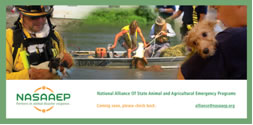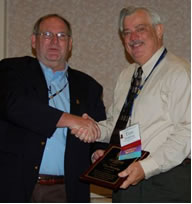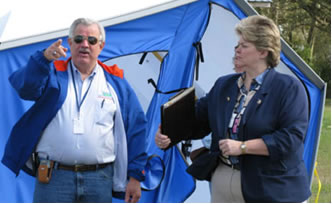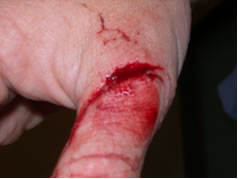
Vol. 6, No.2, Feb 2010 |
 Printer-Friendly PDF Version Printer-Friendly PDF Version |
Contents |
SART Advisory Board Meeting
Please mark your calendar for March 3 for a meeting of the SART Advisory Board. The meeting, which will begin at 10:00 am will be held at the Florida Farm Bureau building at 5700 SW 34th St., Gainesville (352) 378-1321.
 What’s happening with NASAAEP and what could it mean for you? The March Advisory Board meeting at the Farm Bureau, Gainesville will be an excellent chance to find out. A web site at www.nasaaep.org is under construction.
What’s happening with NASAAEP and what could it mean for you? The March Advisory Board meeting at the Farm Bureau, Gainesville will be an excellent chance to find out. A web site at www.nasaaep.org is under construction.Issues and developments include: NASAAEP ( the National Alliance of State Animal and Agricultural Emergency Programs – which is developing an independent web site at www.nasaaep.org ), progress in developing training standards and universally recognized credentials, the formation of a centralized Florida volunteer response network tentatively called Florida DART, plans for the 2011 SART Conference including need-agenda-location, a report by UF/IFAS Extension about damage to the Florida agricultural sector from the January freeze and discussions about accomplishing the mission in difficult economic times.
All this and more on March 3rd at the Florida Farm Bureau building in Gainesville. Questions and comments please contact Florida ESF-17 Coordinator Joe Kight kightj@doacs.state.fl.us or SART Planner Michael Turner turnerm@doacs.state.fl.us.
| Agenda SART Advisory Board Meeting March 3, 2010 |
||
10:00 a.m. |
Welcome |
Dr. Joan Dusky, Co-Chair |
10:15 |
Minutes |
Dr. Joan Dusky |
10:30 |
Haiti Report |
Lloyd Brown, HSUS International |
11:00 |
GHC |
Joe Kight |
11:15 |
April Training |
John Haven and David Perry |
11:30 |
Animal Carcass Disposal |
Dr. Suzan Loerzel |
12:00 |
Break |
|
12:30p.m. |
SART Structure |
Michael Turner |
1:00 |
2011 SART Conference |
Joe Kight |
1:30 |
Open Discussion |
All |
2:00 |
Adjourn |
|
[top]
Course Reminders
Courses offered by WIFSS in cooperation with FDACS for March are:
- AWR-153 Principles of Detection and Diagnosis: Strategies and Technologies
- Wednesday, March 3 – 8:00 am to 4:30 pm at the Miami Regional Operations Center, 1030 NW 111th Avenue, Miami, FL 33172
CONTENT INCLUDES
|
|
- AWR-154 Principles of National Incident Management System (NIMS), Team Building, and Risk Communication
- Thursday, March 4 – 8:00 am to 4:30 pm at the Miami-Dade County Extension Office, Agricultural Center, 18710 SW 288th Street, Homestead, FL 33030
- Tuesday, March 30 – 8:00 am to 4:30 pm at the Palm Beach County, Division of Emergency Management, 20 South Military Trail, West Palm Beach, FL 33415
- Wednesday, March 31 – 8:00 am to 4:30 pm at the Institute of Public Safety (Building 22, Room 155) Broward College Central Campus, 3501 SW Davie Rd, Davie, FL 33314
CONTENT INCLUDES
|
SUGGESTED ATTENDEES
|
Registration: http://wifss.ucdavis.edu/agroterrorism/classes/classesbydate.php
Information: http://wifss.ucdavis.edu/agroterrorism/classes/course_desc.php
Contact John Terry (850-410-6756 or terryj1@doacs.state.fl.us ) with questions.
 |
Courses are free of charge and lunch is provided to registered attendees, thanks to a DHS grant through WIFSS. Additional sponsoring partners include IFAS-Extension, the Department of Health and the Regional Domestic Security Task Forces. |
 |
[top]
Tim Manning Steps Down as SART Chair
Tim Manning has stepped down as Florida SART chair. In his new capacity as Florida State Executive Director for the USDA’s Farm Service Agency, the man who helped put SART on the map in the Sunshine State has discovered that his time is now stretched to its limits.
“Tim has been absolutely instrumental in the development of SART in Florida, chairing conferences and meetings, refereeing difficult questions and fully supporting the multi-agency coordinating role of the organization,” said Joe Kight, ESF-17 ECO. “Because of his enthusiasm for preparedness and education we are much further along in our organizational and training efforts. Tim has been here from the beginning. A great facilitator and a hard worker; a visionary. I’ve often leaned on him for help and will probably continue to do so. While he won’t be serving as chair, he has promised to stay involved and that’s a benefit for the state of Florida.”
 |
 |
| ESF-17 Joe Kight presents Tim Manning with Leadership Award at Clearwater Conference 2007. | SART co-chair and (now) FSA State Director Tim Manning makes a point in conversation with FWCC Captain Linda Harrison during the March 2008 exercise. |
A resident of Gainesville, Manning has more than 30 years with USDA, primarily helping farmers learn about and take advantage of farm subsidy programs. He has served as Acting State Executive Director and Dispute Resolution Coordinator.
He also has experience with the Agricultural Mediation Service, as Homeland Security Emergency Operations Coordinator and as a member of the Catastrophic Planning Committee.
 |
“FSA stands solidly behind SART. Whatever we can do to support the mission, we will do. It has been hard to let go because I truly believe in what this organization does.” Tim Manning “He has made a difference. With Tim’s leadership, we have improved the ability of this state to prepare and to respond.” David Perry |
How Counties Manage...
Making it Work in Calhoun County
Calhoun County specializes in cotton and peanuts. It has a population of about 15,000 people. Its county seat is Blountstown. Much of the county is low-lying land and Calhoun indeed is bounded on the east by the Apalachicola River and is bisected by the Chipola River. So, there’s good news … and bad news.

For anglers, folks who love canoes and kayaks, the area’s water sports are a huge opportunity to enjoy the outdoors. On the other hand, during periods of heavy rain county ESF-17 coordinator Angie Smith says the low-lying regions of the county are particularly prone to flooding. When Ivan went through in September 2004, Calhoun experienced major flooding issues. And contacted by phone in mid-February, Smith – who has worked in emergency operations for more than 10 years – suggested that the county could be close to that tipping point now: “It wouldn’t take much for us to have a large scale flood.”
So how does Calhoun manage to meet its mission in an era when budgets everywhere are extra-tight? “We've been fortunate to not have had any catastrophic disasters since the El Nino flood of 1998," Smith said. “And because there are only three of us here in the county EOC, we all wear multiple hats. That means we do everything from grant writing to struggling with solid waste issues.” A CART for Okeechobee
Part of the Florida Heartland with a population of less than 40,000, Okeechobee is another gem of a small Florida county that is rarely in the national spotlight. From the point of view of its residents, however, that may be just fine. Its county seat is Okeechobee on the north side of the lake of the same name and its economy is based primary on agriculture – 15,000 acres of citrus, with some sweet corn, watermelon and a few greenhouses on the side – and beef cattle with dairy on the side.

Okeechobee Emergency Management Director Michael Faulkner says they are working with Glades County and the Seminole Tribe of Florida to develop a CART (County Agricultural Response Team). Combining resources just makes sense in rural and inland areas of the state, especially when coping with a disaster and especially in lean economic times.
Together, the counties and the Tribe have discussed a scope-of-work agreement as the basis for a response team that could activate quickly for emergencies. Faulkner believes a CART could be developed to perform some on-the-ground reconnaissance (local individuals know the ground and the people) and take immediate action where that is needed in the critical hours (or days) before state and federal resources arrive.
[top]
Cost of Fatal Injuries to Civilian Workers

It isn’t really a secret why some people get hurt on the job is it? (Photo Naval Safety Center).
Demographic data on fatal workplace injury [1992-2001] was captured in the National Traumatic Occupational Fatality Surveillance system, maintained by the National Institute for Occupational Safety and Health. And it’s useful to keep them in mind during disasters when marginally-trained volunteers may double their enthusiasm, but lose their inhibitions.
The document builds upon the surveillance data by adding an economic component; the data in this monograph provide a measure of the economic loss to society from the premature deaths of workers in various economic sectors, by states, to society as a whole, over time, by cause of death, and by demographic characteristics.
Over the period studied the estimated costs from these premature deaths exceeded $43 billion. By state, the greatest number and total societal cost occurred in:
California – 5,173; $4.5 billion
Texas – 4,438; $3.8 billion
Florida – 3,287; $2.8 billion
New York – 2,509; $2.0 billion
Pennsylvania – 2,165; $1.8 billion
Such an order is probably to be expected since the states’ population ranks are respectively: #1 California - 37 million, #2 Texas - 25 million, #3 New York - 20 million, #4 Florida - 19 million, #5 Illinois & Pennsylvania (tie) - 13 million. Dated August 2009 and compiled by Elyce Anne Biddle, PhD, the report is available at www.cdc.gov/niosh/docs/2009-154/pdfs/2009-154.pdf.
Hackers Attack Power Plants
 SART is a multi agency coordination group consisting of governmental and private entities dedicated to all-hazard disaster preparedness, planning, response, and recovery for the animal and agriculture sectors in Florida. Does your county have a plan in case its basic infrastructure is interrupted? Such an event would affect farms and shelters, rescue and recovery operations.
SART is a multi agency coordination group consisting of governmental and private entities dedicated to all-hazard disaster preparedness, planning, response, and recovery for the animal and agriculture sectors in Florida. Does your county have a plan in case its basic infrastructure is interrupted? Such an event would affect farms and shelters, rescue and recovery operations.Apparently it is not just a B-movie thriller or cheap hour of television. According to a report by McAfee Inc., which makes security software, and the Center for Strategic and International Studies (CSIS) in Washington, critical infrastructure in the U.S. – power plants, water and sewage systems, oil and gas pipeline systems, for example – is often subjected to very sophisticated hacking. Manipulating the computer systems could cause power outages, floods, sewage spills and oil leaks. According to the report, “In many cases, foreign governments are suspected.”
The report was based on a survey completed by 600 executives and technology managers from infrastructure operators in 14 countries. It was prepared by McAfee and CSIS, which analyzed the data and conducted additional interviews. The respondents aren't named and specifics aren't given about what happened in the attacks, but the report comes as concerns are growing about state-sponsored hacking and threats to critical infrastructure.
In November, CBS's 60 Minutes reported that several Brazilian power outages were caused by hackers, a report that Brazilian officials have played down. Last April, U.S. government officials said that spies hacked into the U.S. electric grid and left behind computer programs that would let them disrupt service. The intrusions were discovered after electric companies gave the government permission to audit their systems.
The story by Jordan Robertson, Associated Press Technology Writer was printed in the San Francisco Chronicle newspaper January 28th and is available at www.sfgate.com/cgi-bin/article.cgi?f=/n/a/2010/01/28/financial/f070058S40.DTL#ixzz0ePrL3SnX.
[top]Invasive Spread - Lionfish
Is it a SART matter? Well, a recent news report suggests that the non-native lionfish – sort of a cat-dog or tiger-zebra, but under water – now has breeding populations along the entire east coast of Florida and is “wreaking havoc to the marine environment.” Does that fall under the “all-hazard” rubric? Perhaps.
1. This oriental species has established itself from Rhode Island to Caracas, Venezuela having first been spotted in U.S. waters off Miami in 1985.
2. Lionfish eat smaller fish voraciously; lacking natural predators their damage to a natural reef ecosystem and the animal populations that inhabit it is incalculable.
3. A venomous sting from a lionfish spine causes severe pain; they cannot be handled without special gloves.

The exotic and invasive Lionfish has established breeding colonies from New England to Venezuela.
4. Because it is exotic in appearance, lionfish once was a top-10 imported tropical fish for aquariums (Nature Conservancy).
5. This noxious invasion was almost certainly caused when collectors released them into the ocean.
6. Eradicating them is now impossible.
7. Captured in traps at depths rarely frequented by recreational divers, the only apparent control is for humans to hunt them aggressively.
8. After removing the spines, lionfish – which can grow to 18 inches – are quite tasty either as
Here are links to the February 7 article in the Miami Herald newspaper written by Cammy Clark (www.miamiherald.com/news/southflorida/story/1468635.html) and to the most current map (http://nas.er.usgs.gov/taxgroup/fish/lionfishdistribution.asp) of lionfish sightings from the U.S. Geological Survey.
Underwater News of the “Duh…” Speaking of underwater stuff only tangentially related to the SART “all-hazard” mission, on Saturday, February 6, a Riviera Beach fisherman hooked a shark while casting from shore. |
Florida Has Alligators, Too
On September 17, 2007 an alligator attacked a man snorkeling in a fresh water lake in South Carolina where the reptiles are relatively rare. The story and the graphic photos were published in the Charleston Post and Courier newspaper at www.postandcourier.com/photos/galleries/2007/sep/17/alligator_attack/1326/ and at www.snopes.com/photos/gruesome/golferarm.asp. Because the alligator ripped the man’s arm off. Responders killed the gator, removed the arm from its digestive tract and flew the arm to the hospital where the man was being treated.
 Even small alligators can inflict painful bites that are subject to rapid infection. This laceration was caused by a 3-foot gator.
Even small alligators can inflict painful bites that are subject to rapid infection. This laceration was caused by a 3-foot gator.If there is an issue for responders in Florida it is that following an emergency, especially one with a significant area of impact, one can reasonably expect to encounter alligators and other reptiles both in rural and urban areas – perhaps swimming in flooded avenues or even hiding in inundated homes or barns.
According to the Florida Fish & Wildlife Conservation Commission, the overall goal of alligator management is: “Manage Florida’s alligator population for its long-term well-being and the benefits of users.” Thus if you think alligators will not be a concern if you are called upon to respond following a disaster such as a hurricane or a flood, well … don’t be too sure.
“Once a bite takes place, the best thing the victim can do is to fight the alligator and to create as much noise and confusion as possible. The alligator may realize it has made a mistake in biting a large animal it cannot overpower easily, release its grip, and flee.” From FWCC Power Point Presentation and Brochure available at www.myfwc.com/WildlifeHabitats/Alligator_index.htm (emphasis added).
|
About the SART Sentinel |
Editor: Rick Sapp, PhD, Technical Writer, Florida Department of Agriculture & Consumer Services, Division of Animal Industry [rsa5@cox.net] Associate Editor: Joe Kight, State ESF-17 Coordinator, Florida Department of Agriculture & Consumer Services, Division of Animal Industry [kightj@doacs.state.fl.us] The SART SENTINEL is an E-mail newsletter prepared monthly by Rick Sapp and the members of the Florida State Agricultural Response Team. Past issues of the Sentinel are archived on the Florida SART Web Site, www.flsart.org. If you have a story or photo that you would like to have considered for publication in The SART SENTINEL, please contact the Editors. [top] |
